Calorie content and nutritional value of onions: fresh, boiled, fried
Knowing the composition of food products is useful not only for those who are losing weight, but also for those who strive to eat a balanced diet, wisely using the beneficial properties of food for health. From the article you will learn how the calorie content of onions changes depending on the cooking method, what vitamins and microelements are contained in this vegetable, and how to properly use onions to get the maximum benefit from them.
Chemical composition and nutritional value of onions per 100 g
The bulbs contain 8-14% fast carbohydrates (sugars: fructose, sucrose, maltose, polysaccharide inulin), as well as a large amount of vitamins and microelements involved in the most important processes of the human body.
Microelements and vitamins
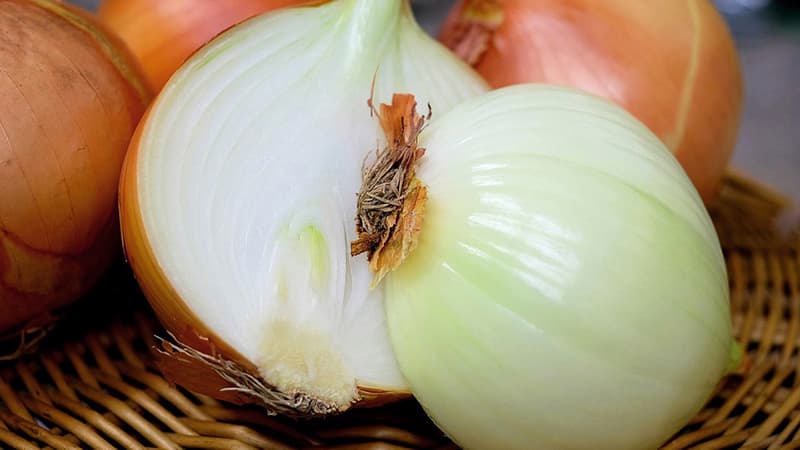
Fresh onions contain the following nutrients (in milligrams):
- calcium - 23;
- iron - 0.2;
- magnesium - 10;
- phosphorus - 29;
- potassium - 146;
- sodium - 4;
- zinc - 0.2;
- copper - 0.039;
- selenium - 0.005;
- fluorine - 0.011.
In addition to these substances, the vegetable contains the following microelements:
- Silicon, stimulating collagen synthesis.
- Cobalt, which is found in vitamin B12. It helps activate enzymes needed for fatty acid metabolism and folic acid metabolism.
- Manganese, necessary for the formation of bone and connective tissue. The element takes an active part in the metabolism of amino acids, carbohydrates, and catecholamines.
In the fresh boiled, fried, stewed, baked Onions contain fat-soluble vitamins: E, K and beta-carotene, as well as water-soluble vitamins: C, B1, B2, B3 (PP), B4, B5, B6 and B9.
In cooked onions
Let's consider the chemical composition of onions with different methods of heat treatment.
Boiled (mg):
- calcium - 22;
- iron - 0.2;
- magnesium - 11;
- phosphorus - 35;
- potassium - 166;
- sodium - 3;
- zinc - 0.2;
- copper - 0.001;
- manganese - 0.2;
- selenium - 0.006.
Roasted (mg):
- calcium - 20;
- iron - 0.3;
- magnesium - 9;
- phosphorus - 33;
- potassium - 133;
- sodium - 12;
- zinc - 0.2;
- copper - 0.06;
- manganese - 0.2;
- selenium - 0.001.

Stewed (mg):
- calcium - 22;
- iron - 0.2;
- magnesium - 11;
- phosphorus - 35;
- potassium - 166;
- sodium - 3;
- zinc - 0.2;
- copper - 0.001;
- manganese - 0.2;
- selenium - 0.006.
Baked (mg):
- calcium - 37;
- iron - 0.9;
- magnesium - 17;
- phosphorus - 71;
- potassium - 212;
- sodium - 4.7;
- zinc - 1;
- copper - 0.1;
- manganese - 0.2.
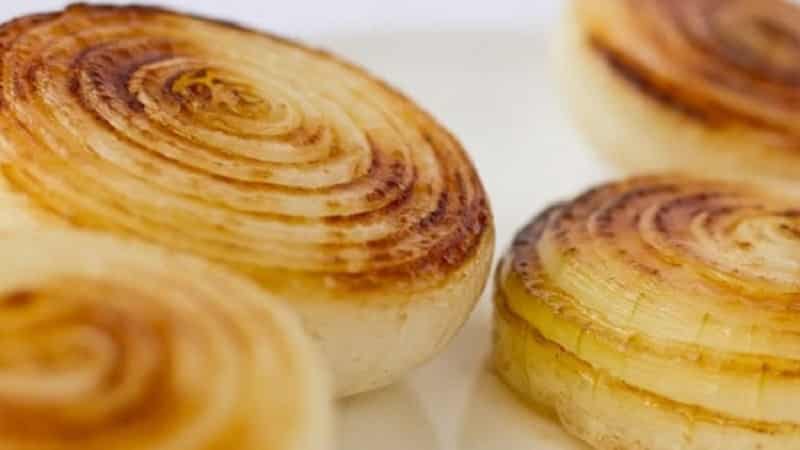
Green onions
Green onions contain fat-soluble vitamins: A, E, K and beta-carotene, as well as water-soluble vitamins: C, B1, B2, B3 (PP), B4, B5, B6 and B9. Besides:
- calcium - 52 mg;
- iron - 0.5 mg;
- magnesium - 16 mg;
- phosphorus - 25 mg;
- potassium - 159 mg;
- sodium - 15 mg;
- zinc - 0.2 mg;
- copper - 0.06 mg;
- manganese - 0.2 mg;
- selenium - 0.2 mcg.
Leek
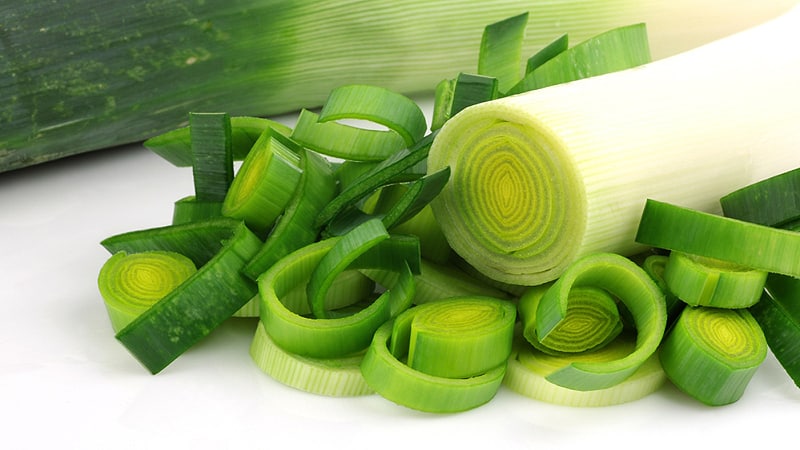
Leeks contain fat-soluble vitamins: A, E, K and beta-carotene, as well as water-soluble vitamins: C, B1, B2, B3 (PP), B4, B5, B6 and B9.
- calcium - 59 mg;
- iron - 2.1 mg;
- magnesium - 28 mg;
- phosphorus - 35 mg;
- potassium - 180 mg;
- sodium - 20 mg;
- zinc - 0.1 mg;
- copper - 0.1 mg;
- manganese - 0.5 mg;
- selenium - 1 mcg.
shallot

shallot contains the following fat-soluble vitamins: E, K and beta-carotene, as well as water-soluble vitamins: C, B1, B2, B3 (PP), B4, B5, B6 and B9.
- calcium - 37 mg;
- iron - 1.2 mg;
- magnesium - 21 mg;
- phosphorus - 60 mg;
- potassium - 334 mg;
- sodium - 12 mg;
- zinc - 0.4 mg;
- copper - 0.1 mg;
- manganese - 0.3 mg;
- selenium - 1.2 mcg.
Bulb
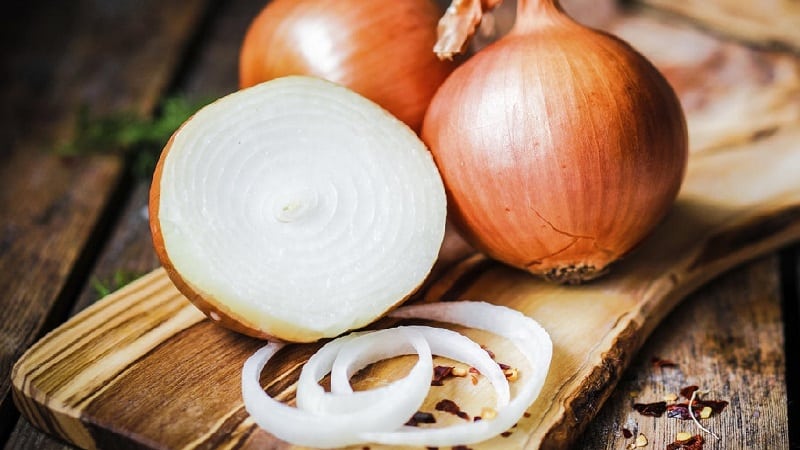
The classic vegetable contains fat-soluble vitamins: A, E, K and beta-carotene, as well as water-soluble vitamins: C, B1, B2, B3 (PP), B4, B5, B6 and B9.
- calcium - 31 mg;
- iron - 0.8 mg;
- magnesium - 14 mg;
- phosphorus - 58 mg;
- potassium - 175 mg;
- sodium - 4 mg.
Sprouted turnips contain the maximum amount of vitamins and minerals. Useful material concentrated in the lower part of the feather, which is white and is located at the exit from the bulb.
Is the composition of red and white onions different?
100 g of red vegetable contains 2 g of fiber, 0.8 g more than white varieties. The bulbs of both colors contain the flavonoid quercetin and antioxidants - active agents in the prevention of heart disease and certain types of cancer.
Important. Flavonoids are concentrated in the outer layers. Red varieties contain more quercetin and anthocyanins. White ones contain more iron and sugars. There are twice as many antioxidants in red onions as in white ones.
Calorie content, BJU and glycemic index of onions per 100 g

Fresh vegetables have a low glycemic index (GI), it does not provoke a sharp rise in blood sugar, and therefore is not contraindicated for people with diabetes. The energy value of the product and GI vary depending on the method of its preparation:
| Method of preparation and type of onion | Calorie content | Proteins, g | Fats, g | Carbohydrates, g | GI |
| fresh | 42 kcal | 1,1 | 0,1 | 9 | 10 |
| boiled | 42 kcal | 1,36 | 0,19 | 8,75 | 15 |
| fried | 258 kcal | 3,2 | 14 | 31 | 98 |
| stew | 48.5 kcal | 1.35 | 0.05 | 7.9 | 15 |
| baked | 36.6 kcal | 1,3 | 1,78 | 8,4 | 15 |
| green onions | 32 kcal | 1,8 | 0,2 | 7 | 39 |
| leek | 61 kcal | 1,5 | 0,3 | 14 | 15 |
| shallot | 72 kcal | 2,5 | 0,1 | 17 | 32 |
| onion | 41 kcal | 1,4 | 0,2 | 8,2 | 10 |
It is worth keeping in mind that when adding salt to onions, its calorie content increases by 2-3 kcal.Other additives, spices, sauces, oils, etc. also play a role. In the same way, the glycemic index changes when cooked - for example, caramelizing onions in sugar will significantly increase the GI.
Is there a difference in calories between red and white onions?
It cannot be said that it is the color of the bulbs that affects its nutritional value. Also, the number of calories depends on the content of proteins, fats and carbohydrates in the vegetable. The calorie content of classic onions is 42 kcal, and sweet varieties - 32-35 kcal. Any onion can be sweet, regardless of color.
Which cooking method has onions the most and least calories?
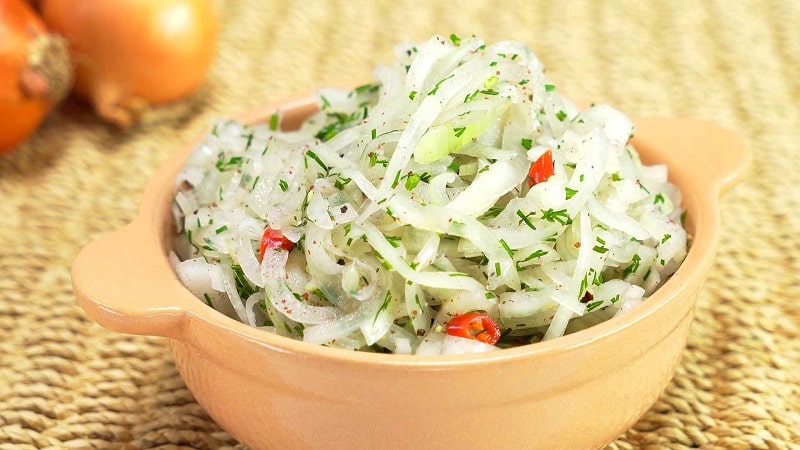
The largest number of calories (349 kcal per 100 g) contains dehydrated (dried) onions, which are flakes.
Reference. This product is produced on an industrial scale using drying machines. All the water, which makes up 90% of the mass of the raw onion, evaporates from the vegetable.
Baked onions contain the least calories. That is why people on diets prepare it this way. To prevent the calorie content from increasing, it is not recommended to add sauces or oil to the vegetable.
Conclusion
Onions in almost any form (except fried) are low in calories. This is especially useful to know for those who want to lose weight. In addition, this vegetable contains many useful substances necessary for humans. Many of them are preserved by heat treatment.